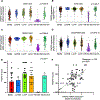TROP2 Expression Across Molecular Subtypes of Urothelial Carcinoma and Enfortumab Vedotin-resistant Cells
- PMID: 35216942
- PMCID: PMC10262920
- DOI: 10.1016/j.euo.2021.11.005
TROP2 Expression Across Molecular Subtypes of Urothelial Carcinoma and Enfortumab Vedotin-resistant Cells
Abstract
Sacituzumab govitecan (SG) is an antibody-drug conjugate (ADC) targeting TROP2, which has recently been approved for treatment-refractory metastatic urothelial cancer (UC). However, the variability of TROP2 expression across different bladder cancer (BC) subtypes, as well as after enfortumab vedotin (EV) exposure, remains unknown. Using gene expression data from four clinical cohorts with >1400 patient samples of muscle-invasive BC and a BC tissue microarray, we found that TROP2 mRNA and protein are highly expressed across basal, luminal, and stroma-rich subtypes, but depleted in the neuroendocrine subtype. In addition, TROP2 mRNA levels are correlated with NECTIN4 mRNA but are more highly expressed than NECTIN4 mRNA in patient cohorts and BC cell lines. Moreover, CRISPR/Cas9-mediated knockdown of TROP2 demonstrates that its expression is one factor governing SG sensitivity. After prolonged EV exposure, cells can downregulate NECTIN4, leading to EV resistance, but retain TROP2 expression and remain sensitive to SG, suggesting nonoverlapping resistance mechanisms to these ADCs. While our findings warrant further validation, they have significant implications for biomarker development, patient selection, and treatment sequencing in the clinic as well as clinical trial design and stratification for metastatic BC patients. PATIENT SUMMARY: In this report, we investigated the expression levels of the drug target TROP2 across different molecular subtypes of bladder cancer in multiple patient cohorts and cell lines. We found high levels of TROP2 in most subtypes except in the neuroendocrine subtype. Overall, TROP2 gene expression is higher than NECTIN4 gene expression, and cells resistant to enfortumab vedotin (EV), a NECTIN4-targeting antibody-drug conjugate, remain sensitive to sacituzumab govitecan (SG). Our findings suggest that SG may be effective across most bladder cancer subtypes, including the bladder cancers previously treated with EV.
Keywords: Antibody-drug conjugate; Bladder cancer; Enfortumab vedotin; Molecular subtypes; Sacituzumab govitecan; Urothelial cancer.
Copyright © 2021 European Association of Urology. Published by Elsevier B.V. All rights reserved.
Conflict of interest statement
Figures


Comment in
-
Towards a Better Understanding of Antibody-Drug Conjugates in Urothelial Carcinoma.Eur Urol Oncol. 2022 Dec;5(6):719-721. doi: 10.1016/j.euo.2022.01.004. Epub 2022 Jan 31. Eur Urol Oncol. 2022. PMID: 35105532 No abstract available.
References
-
- Seiler R, Ashab HAD, Erho N, et al. Impact of molecular subtypes in muscle-invasive bladder cancer on predicting response and survival after neoadjuvant chemotherapy. Eur Urol 2017;72:544–54. - PubMed
Publication types
MeSH terms
Substances
Grants and funding
LinkOut - more resources
Full Text Sources
Medical
Research Materials
Miscellaneous

